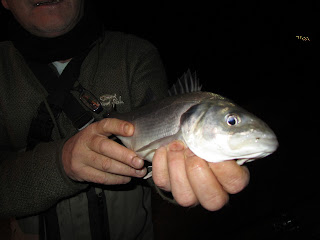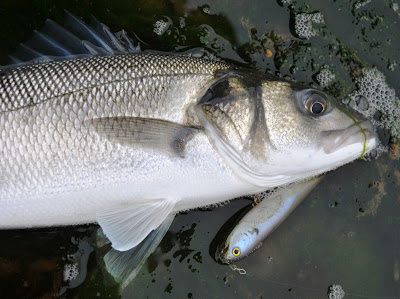Long Trotting for Bass in Estuaries with soft plastic lures i have spoken about before but what a lethal way of Fishing when presented correct,a method that cannot be ignored by any Bass Angler,
Here's a few tips to help you on your way,
Pick your water my personal favourites are the fast moving deep water channels and the slower back eddies of Clearwater lagoons and estuaries moving even further up estuaries into Fresh water ,Bass do lurk in these areas too,,
The choice of rigs and plastics are endless in the world of fishing today, Paddle Tail shads are my personal favourites best when the sea trout are running the estuaries and the and worm type with the sand eel are around both very effective on their day.
For this description I am relating to the paddle tail shad.
Find your area and work out the normally ebbing tide where the most likely place for Bass are going to lie ,on sandy underwater dunes , weed strewn margins, back eddy bait gathering areas, this will come with experience and developing your watercraft and this bit is the fun part,, working it all out,
The approach to trotting is exactly the same as trotting an Avon float for Chub and Barbel species in freshwater a skill I worked out in my younger days that terminal gear is all important which then relates to the natural presentation of the plastic lure to the Bass.
Cast your lure at one o’clock keeping your line as high as possible out of the water by raising your rod tip check and mend your line getting all your line behind the lure keeping as much line out of the water as possible, feel for the paddle tail working, then you are in business, keeping your bail arm disengaged and letting line off between your thumb and forefinger of your left hand giving you controlled trotting your swim with the odd time checking the line feeling for the shad tail working in the current this will tell you the angler that the bait is working weed free and in the zone.
Stopping the Trot will have the effect of lifting the bait off the bottom and restarting will have the effect of dead sticking the bait to the bottom and keeping the line slack, strikes are common in this phase
An upstream wind is ideal for this method, keeping your lure in the Bass zone for a considerable amount of time holding your tackle and lure back in the current, water moving faster than the lure will make your paddle tail work even faster for you with a natural presentation over trots as much as 120yds long and covering vast amounts of ground obviously increasing your chances of a Bass Nailing you with that well presented lure.
The following steps are essential for successful soft plastic lure fishing in estuaries
• Always use the minimum weight (g) that you can possibly get away with 5 to 10g on a worm or paddle tail shad
• Articulated jig heads are a must with the use of short shank hooks for a more natural set up for the plastic lure and will give a natural roll and action to the soft plastic you are using, its all about keeping it real
• In a sensitive environment of clear ,shallow water a fluro carbon leader of 15lbs BS optimum length of around 5 ft Longer leaders with floating greased line are a advanced option
• Concentrate on the presentation of your lure the use of longer light rods will assist with the presentation
• In the shallows of estuaries sight fishing can be so exiting and a pair of top quality Polaroid’s are a must
I have used this method for a long time now and is successful Bass do go for the shads find them
here i have got a few on the burner as we are off shadding in Ireland next week and with the picture above taken on our last trip the excitement is beginning to build,
i have with others probably had more success for larger Bass with the delalande shad with the articulated head than any other lure i own ,for me it is a no1 soft plastic lure,,,







































